Comparative Study of the Photocatalytic Degradation of Crystal Violet Using Ferromagnetic Magnesium Oxide Nanoparticles and MgO-Bentonite Nanocomposite
Abstract
1. Introduction
2. Experimental
2.1. Materials
2.2. Preparation of Magnesium Oxide Nanoparticles (MgO NPs)
2.3. Preparation of Magnesium Oxide–Bentonite (MgO/Ben) Nanocomposite
2.4. Materials Characterizations
2.5. Evaluation of the Photocatalytic Degradation Activity
2.6. Scavenger Experiments
3. Results and Discussion
3.1. Structural Properties
3.2. Electron Microscopy Characterization
3.3. Magnetic Characterization
3.4. UV–Visible Spectroscopy
3.5. Parameters Affecting the Photocatalytic Degradation Process
3.5.1. Effect of Catalyst Dose
3.5.2. Contact Time Effect
3.5.3. Effect of pH
3.5.4. Effect of the Initial Dye Concentration
3.5.5. Trap Experiments
4. Comparative Study
5. Conclusions
Author Contributions
Funding
Institutional Review Board Statement
Informed Consent Statement
Data Availability Statement
Acknowledgments
Conflicts of Interest
References
- Antoniadou, M.; Arfanis, M.; Ibrahim, I.; Falaras, P. Bifunctional g-C3N4/WO3 Thin Films for Photocatalytic Water Purification. Water 2019, 11, 2439. [Google Scholar] [CrossRef]
- Belessiotis, G.; Falara, P.; Ibrahim, I.; Kontos, A. Magnetic Metal Oxide-Based Photocatalysts with Integrated Silver for Water Treatment. Materials 2022, 15, 4629. [Google Scholar] [CrossRef]
- Ibrahim, I.; Belessiotis, G.; Elseman, A.; Mohamed, M.; Ren, Y.; Salama, T.; Mohamed, M. Magnetic TiO2/CoFe2O4 Photocatalysts for Degradation of Organic Dyes and Pharmaceuticals without Oxidants. Nanomaterials 2022, 12, 3290. [Google Scholar] [CrossRef] [PubMed]
- Lucic, M.; Milosavljevic, N.; Radetic, M.; Saponjic, Z.; Radoicic, M.; Krusic, M.K. The potential application of TiO2/hydrogel nanocomposite for removal of various textile azo dyes. Sep. Purif. Technol. 2014, 122, 206–216. [Google Scholar] [CrossRef]
- Yaseen, D.A.; Scholz, M. Textile dye wastewater characteristics and constituents of synthetic effluents: A critical review. Int. J. Environ. Sci. Technol. 2019, 16, 1193–1226. [Google Scholar] [CrossRef]
- Guzel, F.; Saygili, H.; Saygili, G.A.; Koyuncu, F. Decolorisation of aqueous crystal violet solution by a new nanoporous carbon: Equilibrium and kinetic approach. J. Ind. Eng. Chem. 2014, 20, 3375–3386. [Google Scholar] [CrossRef]
- Chahinez, H.O.; Abdelkader, O.; Leila, Y.; Tran, H.N. One-stage preparation of palm petiole-derived biochar: Characterization and application for adsorption of crystal violet dye in water. Environ. Technol. Innov. 2020, 19, 100872. [Google Scholar] [CrossRef]
- Ghaemi, N.; Darabi, F.; Falsafi, M. Dye removal from water using emulsion liquid membrane: Effect of alkane solvents on efficiency. Membr. Water Treat. 2019, 10, 361–372. [Google Scholar] [CrossRef]
- Ayed, L.; Cheriaa, J.; Laadhari, N.; Cheref, A.; Bakhrouf, A. Biodegradation of crystal violet by an isolated Bacillus sp. Ann. Microbiol. 2009, 59, 267–272. [Google Scholar] [CrossRef]
- Ibrahim, I.; Ali, I.O.; Salama, T.M.; Bahgat, A.A.; Mohamed, M.M. Synthesis of magnetically recyclable spinel ferrite (MFe2O4, M = Zn, Co, Mn) nanocrystals engineered by sol gel-hydrothermal technology: High catalytic performances for nitroarenes reduction. Appl. Catal. B-Environ. 2016, 181, 389–402. [Google Scholar] [CrossRef]
- Foroutan, R.; Peighambardoust, S.J.; Peighambardoust, S.H.; Pateiro, M.; Lorenzo, J.M. Adsorption of Crystal Violet Dye Using Activated Carbon of Lemon Wood and Activated Carbon/Fe3O4 Magnetic Nanocomposite from Aqueous Solutions: A Kinetic, Equilibrium and Thermodynamic Study. Molecules 2021, 26, 2241. [Google Scholar] [CrossRef] [PubMed]
- Patel, A.; Soni, S.; Mittal, J.; Mittal, A.; Arora, C. Sequestration of crystal violet from aqueous solution using ash of black turmeric rhizome. Desalination Water Treat. 2021, 220, 342–352. [Google Scholar] [CrossRef]
- Han, F.; Kambala, V.S.R.; Srinivasan, M.; Rajarathnam, D.; Naidu, R. Tailored titanium dioxide photocatalysts for the degradation of organic dyes in wastewater treatment: A review. Appl. Catal. A-Gen. 2009, 359, 25–40. [Google Scholar] [CrossRef]
- Ibrahim, I.; Athanasekou, C.; Manolis, G.; Kaltzoglou, A.; Nasikas, N.K.; Katsaros, F.; Devlin, E.; Kontos, A.G.; Falaras, P. Photocatalysis as an advanced reduction process (ARP): The reduction of 4-nitrophenol using titania nanotubes-ferrite nanocomposites. J. Hazard. Mater. 2019, 372, 37–44. [Google Scholar] [CrossRef] [PubMed]
- Ibrahim, I.; Kaltzoglou, A.; Athanasekou, C.; Katsaros, F.; Devlin, E.; Kontos, A.G.; Ioannidis, N.; Perraki, M.; Tsakiridis, P.; Sygellou, L.; et al. Magnetically separable TiO2/CoFe2O4/Ag nanocomposites for the photocatalytic reduction of hexavalent chromium pollutant under UV and artificial solar light. Chem. Eng. J. 2020, 381, 122730. [Google Scholar] [CrossRef]
- Mohamed, M.M.; Ibrahim, I.; Salama, T.M. Rational design of manganese ferrite-graphene hybrid photocatalysts: Efficient water splitting and effective elimination of organic pollutants. Appl. Catal. A-Gen. 2016, 524, 182–191. [Google Scholar] [CrossRef]
- Ibrahim, I.; Belessiotis, G.V.; Antoniadou, M.; Kaltzoglou, A.; Sakellis, E.; Katsaros, F.; Sygellou, L.; Arfanis, M.K.; Salama, T.M.; Falaras, P. Silver decorated TiO2/g-C3N4 bifunctional nanocomposites for photocatalytic elimination of water pollutants under UV and artificial solar light. Results Eng. 2022, 14, 100470. [Google Scholar] [CrossRef]
- Ibrahim, I.; Belessiotis, G.V.; Arfanis, M.K.; Athanasekou, C.; Philippopoulos, A.I.; Mitsopoulou, C.A.; Romanos, G.E.; Falaras, P. Surfactant Effects on the Synthesis of Redox Bifunctional V2O5 Photocatalysts. Materials 2020, 13, 4665. [Google Scholar] [CrossRef]
- Liu, C.; Mao, S.; Wang, H.L.; Wu, Y.; Wang, F.Y.; Xia, M.Z.; Chen, Q. Peroxymonosulfate-assisted for facilitating photocatalytic degradation performance of 2D/2D WO3/BiOBr S-scheme heterojunction. Chem. Eng. J. 2022, 430, 132806. [Google Scholar] [CrossRef]
- Ahmad, S.; Yasin, A. Photocatalytic degradation of deltamethrin by using Cu/TiO2/bentonite composite. Arab. J. Chem. 2020, 13, 8481–8488. [Google Scholar] [CrossRef]
- Rashad, S.; Zaki, A.H.; Farghali, A.A. Morphological effect of titanate nanostructures on the photocatalytic degradation of crystal violet. Nanomater. Nanotechnol. 2019, 9, 1847980418821778. [Google Scholar] [CrossRef]
- El Bouraie, M.; Ibrahim, S. Differentiation Between Metronidazole Residues Disposal by Using Adsorption and Photodegradation Processes Onto MgO Nanoparticles. Int. J. Nanomed. 2020, 15, 7117–7141. [Google Scholar] [CrossRef] [PubMed]
- Suresh, S.; Arivuoli, D. Synthesis and characterization of Pb+ doped MgO nanocrystalline particles. Dig. J. Nanomater. Biostruct. 2011, 6, 1597–1603. [Google Scholar]
- Camtakan, Z.; Erenturk, S.; Yusan, S. Magnesium oxide nanoparticles: Preparation, characterization, and uranium sorption properties. Environ. Prog. Sustain. Energy 2012, 31, 536–543. [Google Scholar] [CrossRef]
- Mohan, S.; Vellakkat, M.; Aravind, A.; Reka, U. Hydrothermal synthesis and characterization of Zinc Oxide nanoparticles of various shapes under different reaction conditions. Nano Express 2020, 1. [Google Scholar] [CrossRef]
- Al-Shahrani, S. Phenomena of Removal of Crystal Violet from Wastewater Using Khulays Natural Bentonite. J. Chem. 2020, 2020, 4607657. [Google Scholar] [CrossRef]
- Wang, Q.; Rhimi, B.; Wang, H.; Wang, C.Y. Efficient photocatalytic degradation of gaseous toluene over F-doped TiO2/exfoliated bentonite. Appl. Surf. Sci. 2020, 530, 147286. [Google Scholar] [CrossRef]
- Wang, Z.; Xu, C.L.; Wang, H.F. A Facile Preparation of Highly Active Au/MgO Catalysts for Aerobic Oxidation of Benzyl Alcohol. Catal. Lett. 2014, 144, 1919–1929. [Google Scholar] [CrossRef]
- Raghavendra, M.; Lalithamba, H.S.; Sharath, B.S.; Rajanaika, H. Synthesis of N-alpha- protected formamides from amino acids using MgO nano catalyst: Study of molecular docking and antibacterial activity. Sci. Iran. 2017, 24, 3002–3013. [Google Scholar] [CrossRef]
- Hebbar, R.S.; Isloor, A.M.; Prabhu, B.; Inamuddin; Asiri, A.M.; Ismail, A.F. Removal of metal ions and humic acids through polyetherimide membrane with grafted bentonite clay. Sci. Rep. 2018, 8, 4665. [Google Scholar] [CrossRef]
- Silva, I.A.; Costa, J.M.R.; Menezes, R.R.; Ferreira, H.S.; Neves, G.D.; Ferreira, H.C. Studies of new occurrences of bentonite clays in the State of Paraiba for use in water based drilling fluids. Rem-Rev. Escola De Minas 2013, 66, 485–491. [Google Scholar] [CrossRef]
- Taourati, R.; Khaddor, M.; Laghzal, A.; El Kasmi, A. Facile one-step synthesis of highly efficient single oxide nanoparticles for photocatalytic application. Sci. Afr. 2020, 8, e00305. [Google Scholar] [CrossRef]
- Anaissi, F.J.; Demets, G.J.F.; Toma, H.E.; Dovidauskas, S.; Coelho, A.C.V. Characterization and properties of mixed bentonite-vanadium(V) oxide xerogels. Mater. Res. Bull. 2001, 36, 289–306. [Google Scholar] [CrossRef]
- Uchino, T. Optical and Magnetic Properties of Defective MgO Microcrystals; The Electrochemical Society: Pennington, NJ, USA, 2013; pp. 657–8501. [Google Scholar]
- Mohandes, F.; Davar, F.; Salavati-Niasari, M. Magnesium oxide nanocrystals via thermal decomposition of magnesium oxalate. J. Phys. Chem. Solids 2010, 71, 1623–1628. [Google Scholar] [CrossRef]
- Khairnar, S.D.; Patil, M.R.; Shrivastava, V.S. Hydrothermally synthesized nanocrystalline Nb2O5 and its visible-light photocatalytic activity for the degradation of congo red and methylene blue. Iran. J. Catal. 2018, 8, 143–150. [Google Scholar]
- Phan, T.T.N.; Nikoloski, A.N.; Bahri, P.A.; Li, D. Heterogeneous photo-Fenton degradation of organics using highly efficient Cu-doped LaFeO3 under visible light. J. Ind. Eng. Chem. 2018, 61, 53–64. [Google Scholar] [CrossRef]
- Serpone, N. Heterogeneous Photocatalysis and Prospects of TiO2-Based Photocatalytic DeNOxing the Atmospheric Environment. Catalysts 2018, 8, 553. [Google Scholar] [CrossRef]
- Mohamed, S.K.; Hegazy, S.H.; Abdelwahab, N.A.; Ramadan, A.M. Coupled adsorption-photocatalytic degradation of crystal violet under sunlight using chemically synthesized grafted sodium alginate/ZnO/graphene oxide composite. Int. J. Biol. Macromol. 2018, 108, 1185–1198. [Google Scholar] [CrossRef]
- Ahmad, W.; Khan, A.; Ali, N.; Khan, S.; Uddin, S.; Malik, S.; Khan, H.; Bilal, M. Photocatalytic degradation of crystal violet dye under sunlight by chitosan-encapsulated ternary metal selenide microspheres. Environ. Sci. Pollut. Res. 2021, 28, 8074–8087. [Google Scholar] [CrossRef]
- Mittal, M.; Sharma, M.; Pandey, O.P. Photocatalytic Studies of Crystal Violet Dye Using Mn Doped and PVP Capped ZnO Nanoparticles. J. Nanosci. Nanotechnol. 2014, 14, 2725–2733. [Google Scholar] [CrossRef]
- Sharma, M.; Jain, T.; Singh, S.; Pandey, O.P. Photocatalytic degradation of organic dyes under UV-Visible light using capped ZnS nanoparticles. Sol. Energy 2012, 86, 626–633. [Google Scholar] [CrossRef]
- Pawar, K.K.; Chaudhary, L.S.; Mali, S.S.; Bhat, T.S.; Sheikh, A.D.; Hong, C.K.; Patil, P.S. In2O3 nanocapsules for rapid photodegradation of crystal violet dye under sunlight. J. Colloid Interface Sci. 2020, 561, 287–297. [Google Scholar] [CrossRef] [PubMed]
- Abbas, H.A.; Nasr, R.A.; Abu-Zurayk, R.; Al Bawab, A.; Jamil, T.S. Decolourization of crystal violet using nano-sized novel fluorite structure Ga2Zr2-xWxO7 photocatalyst under visible light irradiation. R. Soc. Open Sci. 2020, 7, 191632. [Google Scholar] [CrossRef] [PubMed]
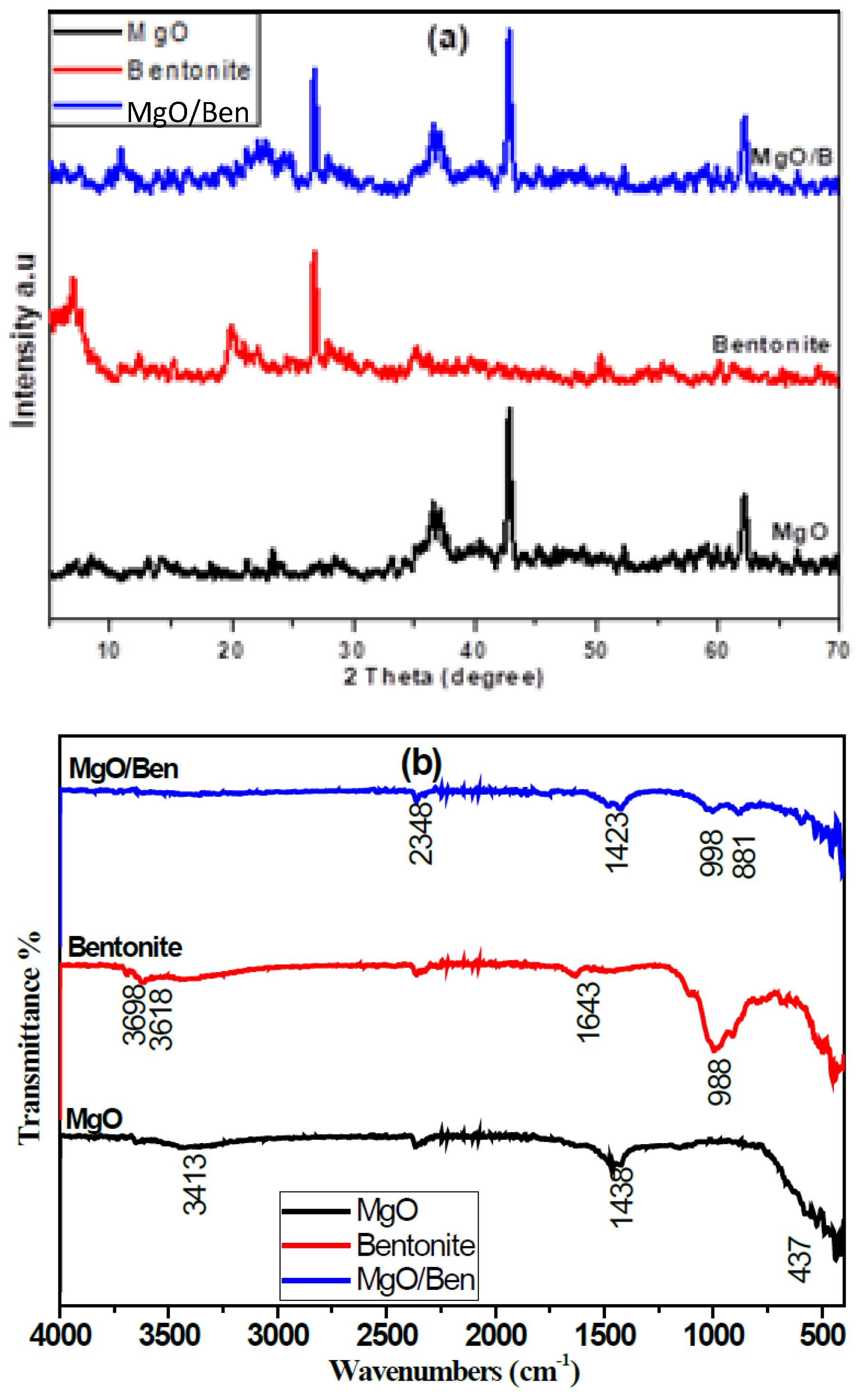
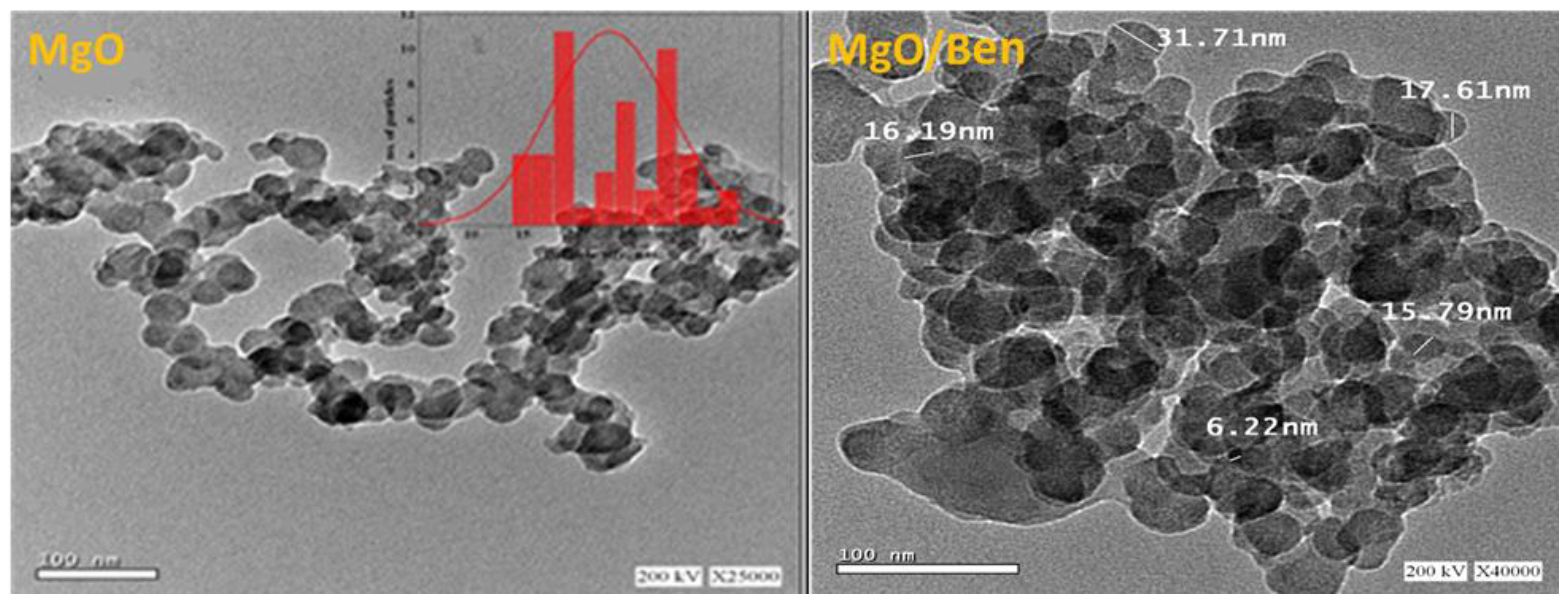


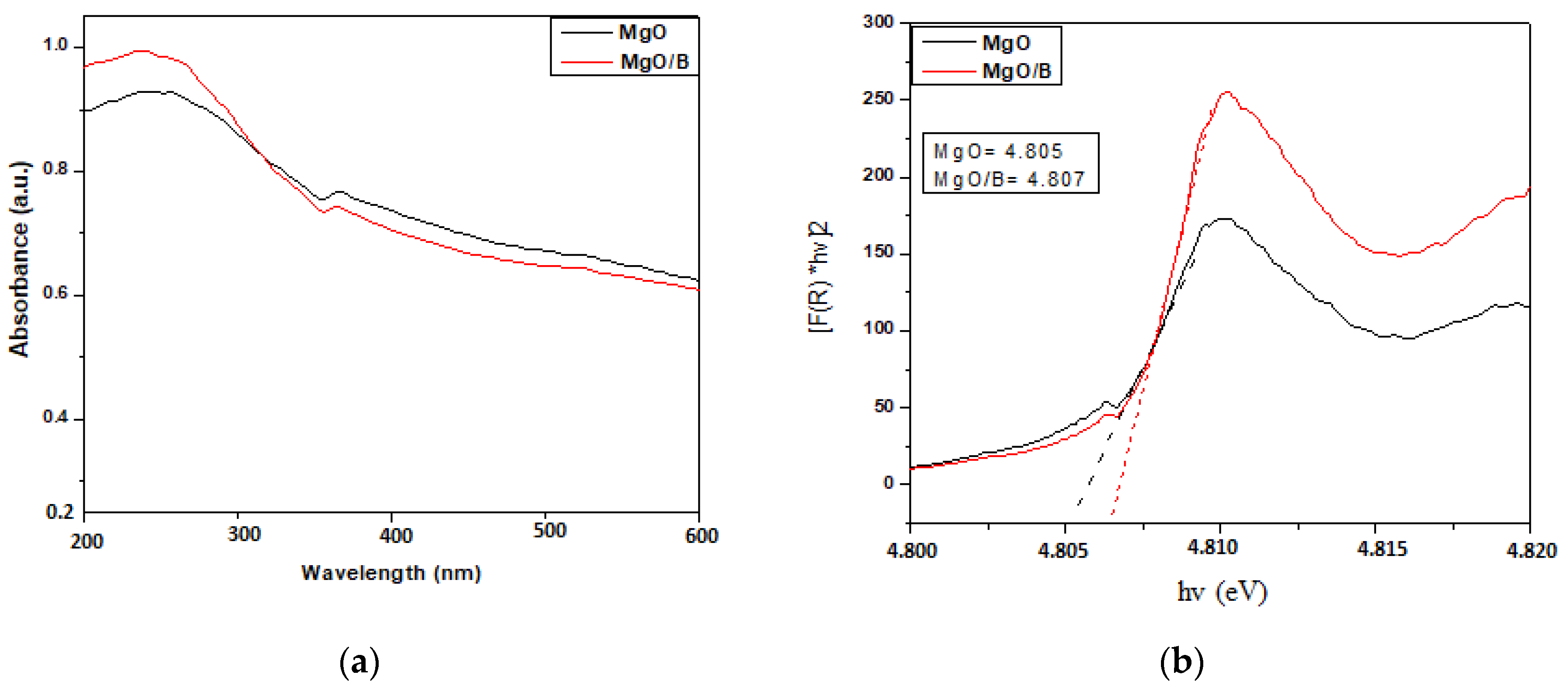
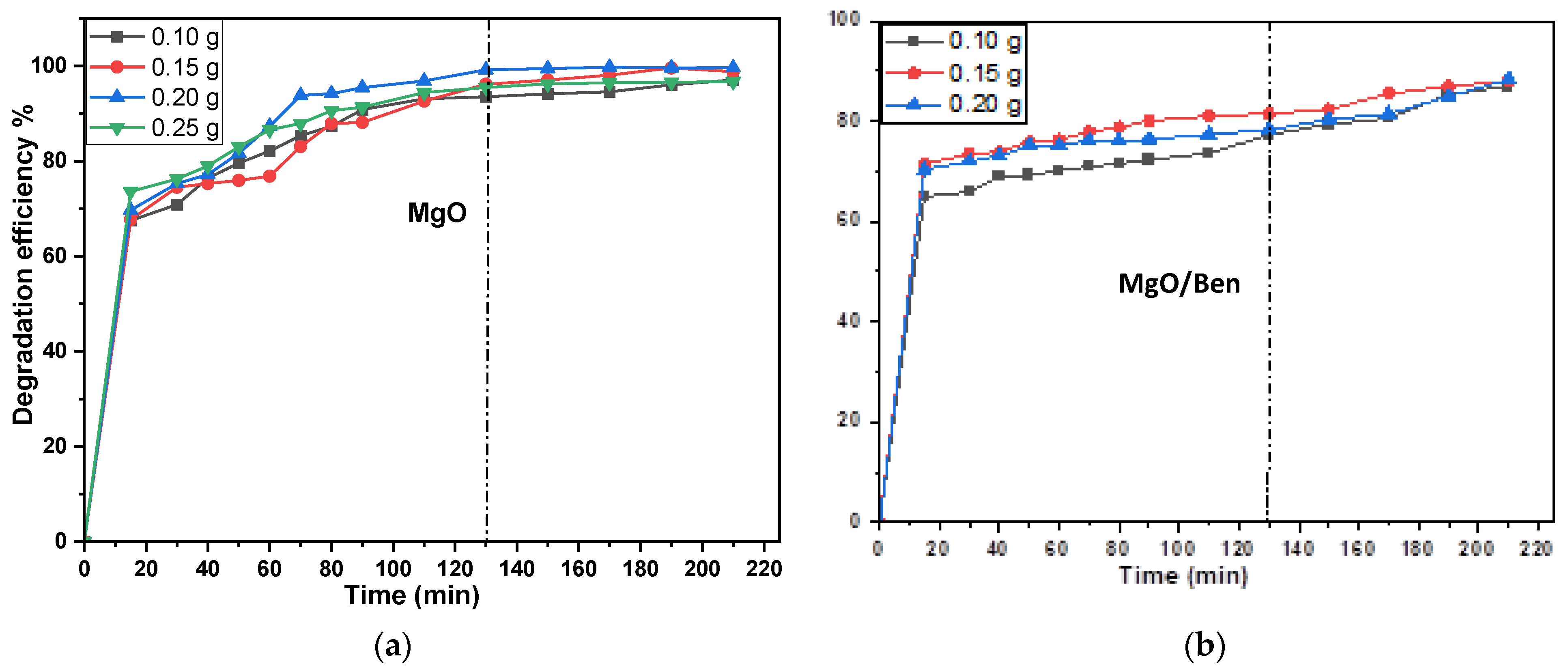
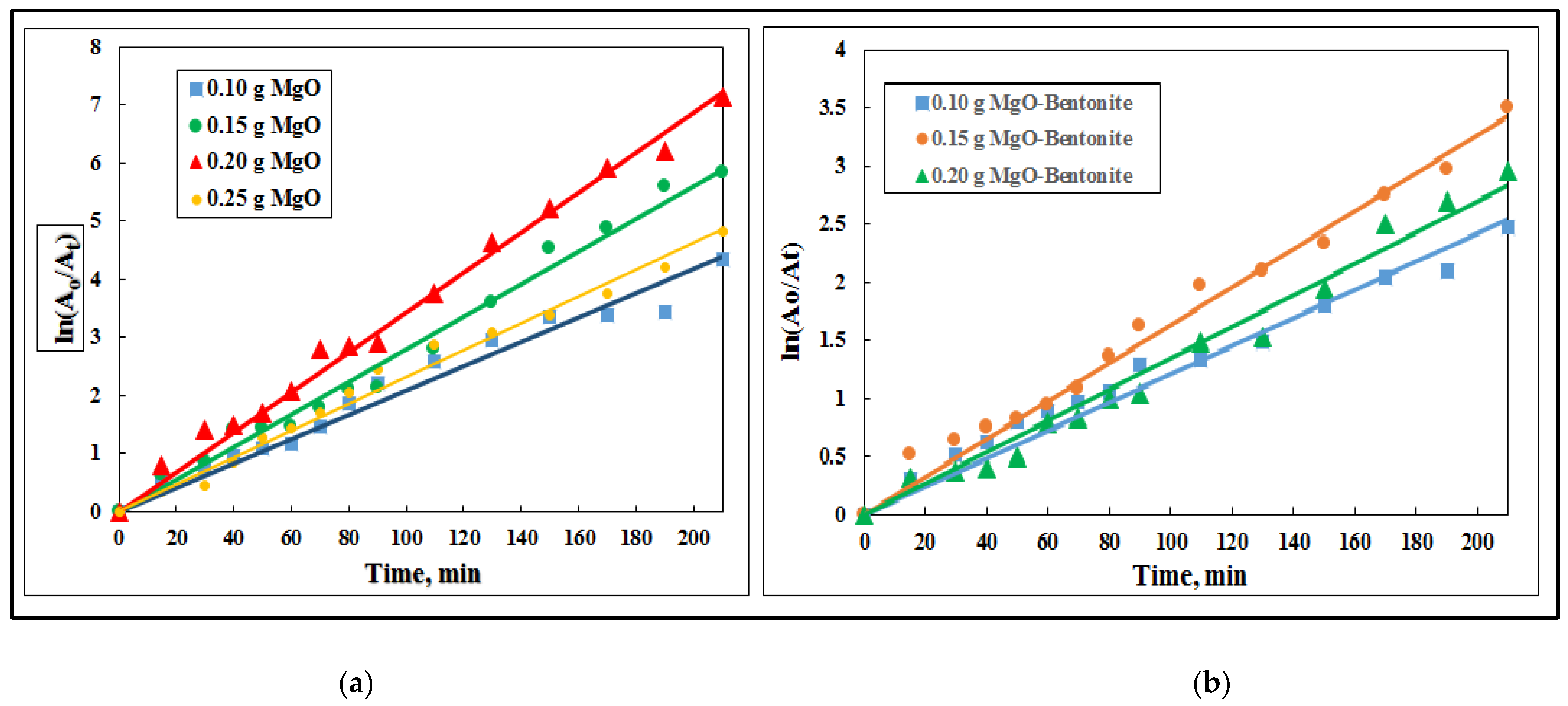
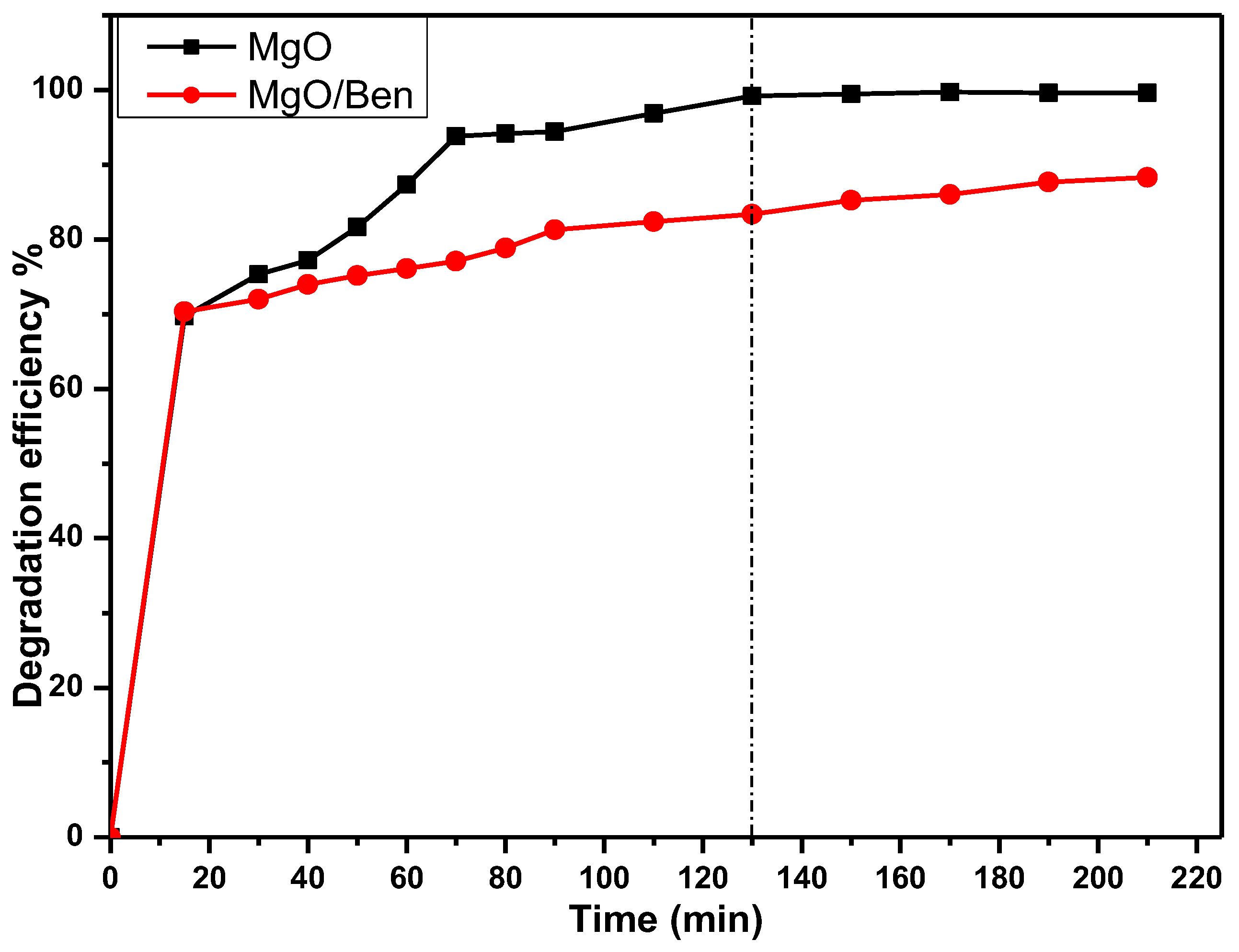


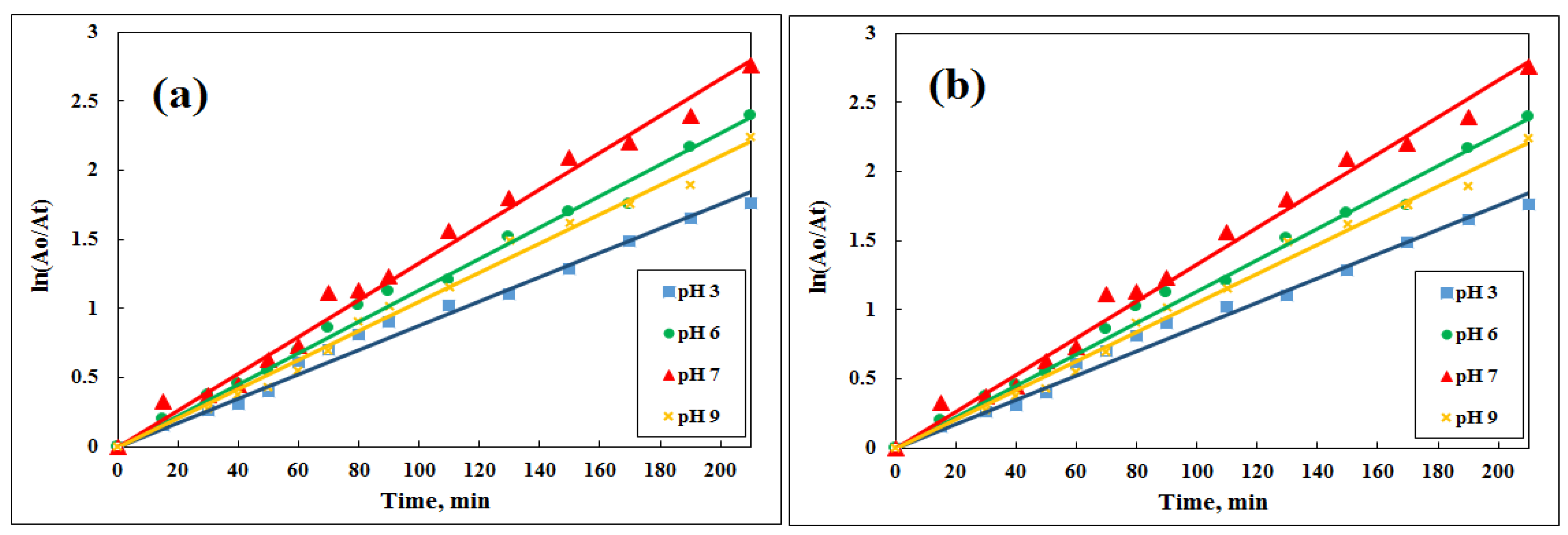

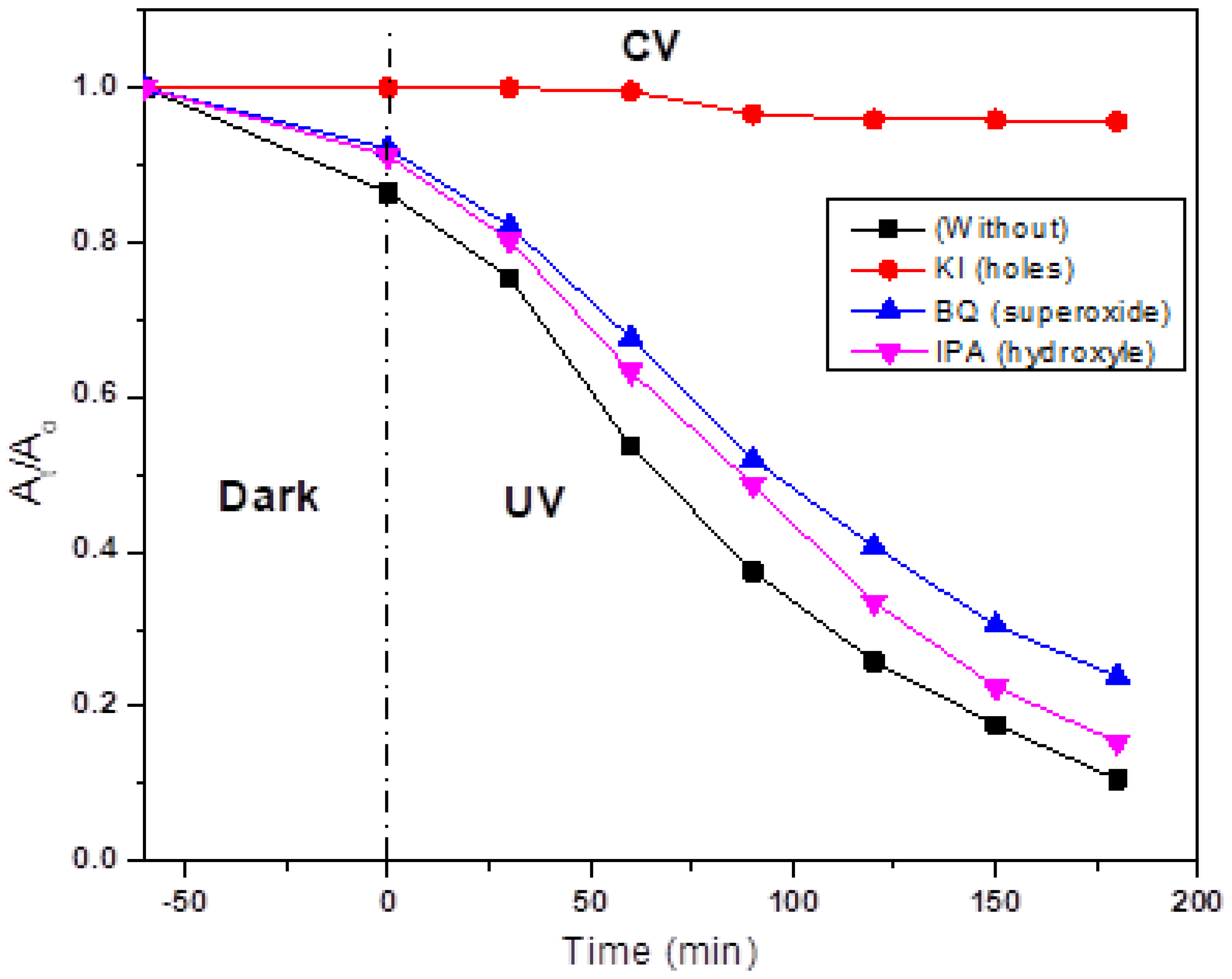
| Catalyst Dose (g) | Kap (min−1) | R2 | Degradation Efficiency % | |||
|---|---|---|---|---|---|---|
| MgO | MgO-Bentonite | MgO | MgO-Bentonite | MgO | MgO-Bentonite | |
| 0.10 | 0.0209 | 0.0121 | 0.9684 | 0.9661 | 93.52 | 77.25 |
| 0.15 | 0.0281 | 0.0163 | 0.9865 | 0.9866 | 96.14 | 83.38 |
| 0.20 | 0.0343 | 0.0136 | 0.9911 | 0.9794 | 99.19 | 78.19 |
| 0.25 | 0.0232 | - | 0.9847 | - | 95.48 | - |
| Contact Time (min) | MgO | MgO/Ben |
|---|---|---|
| 0 | 0 | 0 |
| 15 | 69.69 | 70.34 |
| 30 | 75.30 | 71.98 |
| 40 | 77.18 | 73.99 |
| 50 | 81.66 | 75.18 |
| 60 | 87.31 | 76.09 |
| 70 | 93.81 | 77.09 |
| 80 | 94.10 | 78.83 |
| 90 | 94.44 | 81.29 |
| 110 | 96.86 | 82.39 |
| 130 | 99.19 | 83.38 |
| 150 | 99.46 | 85.21 |
| 170 | 99.73 | 86.04 |
| 190 | 99.59 | 87.68 |
| 210 | 99.64 | 88.32 |
| pH | Kap (min−1) | R2 | Degradation Efficiency % | |||
|---|---|---|---|---|---|---|
| MgO NPs | MgO-Bentonite Nanocomposite | MgO NPs | MgO-Bentonite Nanocomposite | MgO NPs | MgO-Bentonite Nanocomposite | |
| 3 | 0.0238 | 0.0088 | 0.9877 | 0.9876 | 94.58 | 74.87 |
| 6 | 0.0268 | 0.0113 | 0.9931 | 0.9991 | 95.22 | 81.77 |
| 7 | 0.0343 | 0.0133 | 0.9911 | 0.9885 | 99.19 | 83.38 |
| 9 | 0.0257 | 0.0105 | 0.9909 | 0.9914 | 95.86 | 77.46 |
| Initial Dye Concentration (mg L−1) | Degradation Efficiency % (MgO NPs) | Degradation Efficiency % (MgO/Ben Nanocomposite) |
|---|---|---|
| 10 | 99.19 | 83.38 |
| 25 | 98.48 | 60.48 |
| 50 | 97.07 | 57.76 |
| Catalyst | Degradation Efficiency % | Conditions | Ref. | ||
|---|---|---|---|---|---|
| Dose (g) | Time (h) | pH | |||
| Ga2Zr2−xWxO7/H2O2 | 100 | 1.00 | 5 | 9 | [44] |
| Grafted sodium alginate/ZnO/graphene oxide | 94.12 | 1.00 | 5 | 5 | [39] |
| Iron–bismuth selenide–chitosan microspheres | 98.95 | 0.20 | 2.5 | 8 | [40] |
| Anatase Nanosphere TiO2 | 99.38 | _____ | 6 | 7 | [17] |
| Mn-doped and PVP-capped ZnO NPs | 99.13 | 0.25 | 3 | __ | [41] |
| TG-capped ZnS NPs | 87.23 | 0.25 | 3 | __ | [42] |
| Indium oxide (In2O3) nanocapsule | 90.00 | 0.10 | 3 | __ | [43] |
| MgO NPs | 99.19 | 0.20 | 2.16 | 7 | Present work |
| Parameters | MgO NPs | MgO/Ben |
|---|---|---|
| pH | 7 | 7 |
| Initial dye concentration (mg L−1) | 10 | 10 |
| Catalyst dose (g) | 0.20 | 0.15 |
| Time (min) | 130 | 130 |
| Degradation efficiency % | 99.19 | 83.38 |
| Kinetics | Pseudo-first-order | Pseudo-first-order |
Disclaimer/Publisher’s Note: The statements, opinions and data contained in all publications are solely those of the individual author(s) and contributor(s) and not of MDPI and/or the editor(s). MDPI and/or the editor(s) disclaim responsibility for any injury to people or property resulting from any ideas, methods, instructions or products referred to in the content. |
© 2023 by the authors. Licensee MDPI, Basel, Switzerland. This article is an open access article distributed under the terms and conditions of the Creative Commons Attribution (CC BY) license (https://creativecommons.org/licenses/by/4.0/).
Share and Cite
Elashery, S.E.A.; Ibrahim, I.; Gomaa, H.; El-Bouraie, M.M.; Moneam, I.A.; Fekry, S.S.; Mohamed, G.G. Comparative Study of the Photocatalytic Degradation of Crystal Violet Using Ferromagnetic Magnesium Oxide Nanoparticles and MgO-Bentonite Nanocomposite. Magnetochemistry 2023, 9, 56. https://doi.org/10.3390/magnetochemistry9020056
Elashery SEA, Ibrahim I, Gomaa H, El-Bouraie MM, Moneam IA, Fekry SS, Mohamed GG. Comparative Study of the Photocatalytic Degradation of Crystal Violet Using Ferromagnetic Magnesium Oxide Nanoparticles and MgO-Bentonite Nanocomposite. Magnetochemistry. 2023; 9(2):56. https://doi.org/10.3390/magnetochemistry9020056
Chicago/Turabian StyleElashery, Sally E. A., Islam Ibrahim, Hassanien Gomaa, Mohamed M. El-Bouraie, Ihab A. Moneam, Shimaa S. Fekry, and Gehad G. Mohamed. 2023. "Comparative Study of the Photocatalytic Degradation of Crystal Violet Using Ferromagnetic Magnesium Oxide Nanoparticles and MgO-Bentonite Nanocomposite" Magnetochemistry 9, no. 2: 56. https://doi.org/10.3390/magnetochemistry9020056
APA StyleElashery, S. E. A., Ibrahim, I., Gomaa, H., El-Bouraie, M. M., Moneam, I. A., Fekry, S. S., & Mohamed, G. G. (2023). Comparative Study of the Photocatalytic Degradation of Crystal Violet Using Ferromagnetic Magnesium Oxide Nanoparticles and MgO-Bentonite Nanocomposite. Magnetochemistry, 9(2), 56. https://doi.org/10.3390/magnetochemistry9020056








